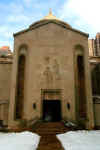 |
New York Architecture Images-Gramercy Park St. Vartan Cathedral (Armenian Orthodox) |
|||||||||
|
architect |
||||||||||
|
location |
620 Second Ave. | |||||||||
|
date |
1959 | |||||||||
|
style |
||||||||||
|
construction |
sheathed in limestone with one story granite base and exterior staircase. | |||||||||
|
type |
Church | |||||||||
|
|
||||||||||
|
images |
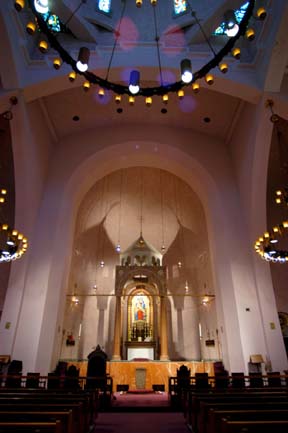 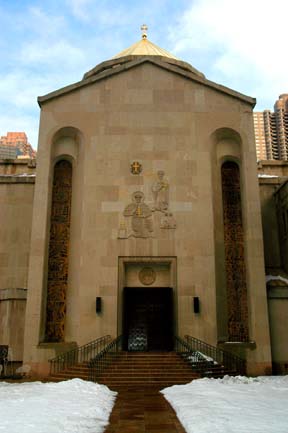 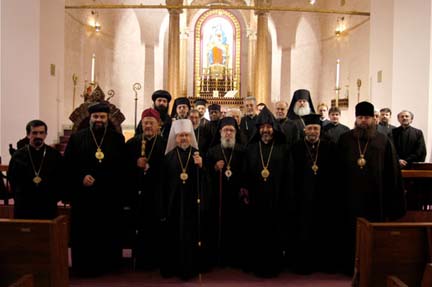 |
|||||||||
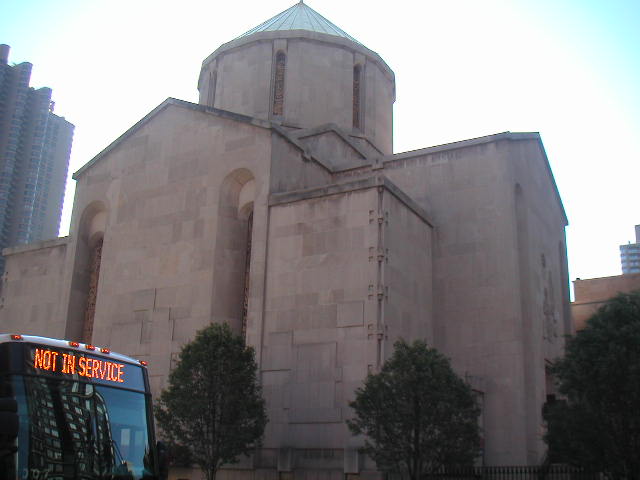  |
||||||||||
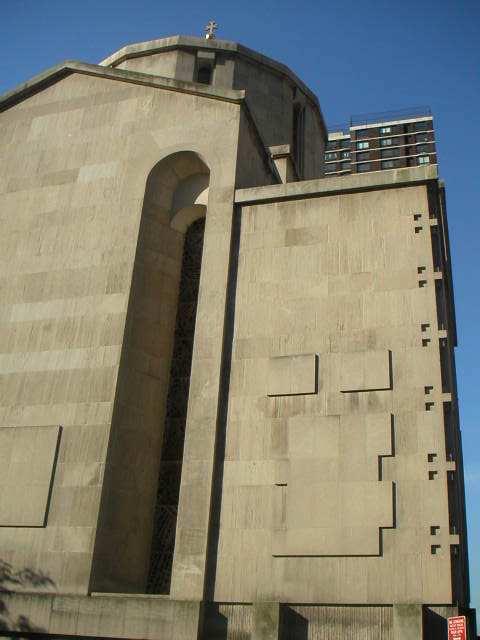 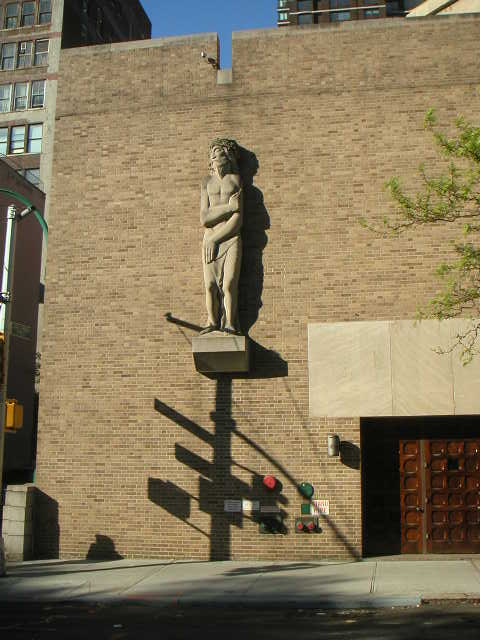 |
||||||||||
|
|
||||||||||
|
The first cathedral of the Armenian Orthodox
Church to be built in North America, it was consecrated in 1959 and
designed to resemble the 4th Century Cathedral of Holy Etchmiadzin in
Armenia. The Gullabi Gulbenkian Cultural Center was added in 1967.
Vartan was a general who fought against Persia's effort to forcibly convert the Armenians to Zorastrianism. The statue on the corner is Descent From the Cross by Reuben Nakian.
|
||||||||||
An Armenian Cathedral in New York
The Architecture
Armenia
|
||||||||||
|
The Artistry of St. Vartan Cathedral
Its Architectural Heritage The Cathedral's architectural plan is patterned after the 4th century church of St. Hripsime in Armenia, and includes two distinctive features of Armenian Church architecture. The first is the use of the double-intersecting arches to span the interior space, eliminated the need for the supporting columns familiar in other types of churches. In early Armenian churches, these arches were stone; for St. Vartan Cathedral, the architects substituted steel, which eliminated the need for massive supporting walls. The second feature is the pyramidal dome, which soars 120 feet above the street level. The dome is supported by a drum, 27 feet high and 45 feet in diameter, which is supported in turn by the intersecting arches. Around the dome are various Christian symbols: the Armenian equivalent of "I am"; the eye, set within a triangle, representing the omniscience of the Triune God; the figure of Jesus Christ; the Holy Spirit represented by a dove; a ship for the Church; the Greek letters alpha and omega superimposed on the scriptures, symbolizing God as the beginning and end of all things; wheat and grapes representing the Eucharist; a heart, an anchor, and a cross symbolizing love, hope, and faith; the Phoenix, the legendary bird of reincarnation, symbolizing resurrection. The New York architectural firm Steinman, Cain & White, with Edward Utudjian of Paris as a consultant designed the Cathedral. The Art that Fills the Cathedral The artist Bogdan Grom depicted scenes of the story of the creation in the eight pierced windows of the drum; for the skylight windows, he chose to represent symbolically the four evangelists Matthew (the Angel-man), Mark (the Lion), Luke (the Ox), and John (the Eagle). The same symbols appear on the door handles of the Cathedral. Below the dome, a series of high, narrow, stained-glass windows, each crowned with a rounded arch, are set into the main walls of the cathedral. Two of the windows depict scenes in the life of Christ -- the Annunciation, the Nativity, the Baptism, the Passion, the Crucifixion, and the Resurrection. Another set of windows depicts scenes form the book of Genesis and the early history of Christianity in Armenia, including the settling of Noah's Ark on Mt. Ararat and portraits of the Apostles Thaddeus and Bartholomew as well as Santookht, the first woman martyr in Armenian history. The profit Ezekiel is shown with an angel reaching out toward the skeletons below, commemorating the 2 million Armenians massacred by the Turks in 1915. The patron saint of the cathedral, St. Vartan, is depicted fighting the Persians who threatened the Armenian Church during the fifth century. The invention of the Armenian alphabet is remembered in portraits of St. Sahag and St. Mesrob. The ecumenical Council of Nicaea (325 A.D.), which produced the Nicene Creed, is illustrated in three scenes form the Council. Finally, the spirit of ecumenicism is symbolized in the portrait of St. Nersess and the crosses of Christendom. Armenian Orthodox Mark Church's
1,700th Anniversary
|
||||||||||
|
THE BATTLE OF VARTANANTZ
The Context for the Battle The Vartanantz' crisis occurred during the reign of King Yazdagird II of Persia, who ruled from A.D. 439 to 456. At the beginning of his reign, King Yazdagird II declared war on the Greeks, who, however being incapable of opposing him signed a peace treaty in 444, paying an annual tribute, and relinquishing to the tender mercy of the pagan Persians all of the former Christian subjects who had sought refuge with them [the Greeks]. The Armenians could not expect anything from Constantinople where an incompetent prince named Theodosius II bore the imperial crown, but the real power rested in the hands of a woman, Pulcheria (408-457), at a time when Attila's Huns were creating havoc in Europe and posing a threat to Constantinople. The Sasanian Shahs occasionally took a lenient attitude toward Christianity and Judaism, but more frequently they maltreated and persecuted them in matters of religion and state. Christianity, especially the kind that was in communion with the Universal Church, was detestable to the Persians, since it constituted a bond between their Western subjects and the Greeks, and an obstacle to the integration of various elements in the state. The two striking accomplishments during the reign of Yazdagird II were, first, the persecutions against the Christians and Jews, and second, the endless wars against the White Huns and Hephthalites who lived on the eastern borders of Persia. Yazdagird's efforts failed in both ventures, and we can perhaps state that at least on this occasion the barbaric Turks unintentionally assisted the Christians in making the implementation of Yazdagird's disastrous plan come to naught. In order to understand the real meaning of the passionate, tearful and bloody disturbances during the Vartanantz war and its sequel in Armenia, it is necessary to keep in mind the well-known religio-political aims of the Sasanian government. The Magi exercised a domineering influence on the Sasanian court, which on many occasions expressed its authority to its subjects of other religious persuasions with fire and the sword. This stubborn and opportunistic policy of propaganda forged in Ctesiphon (the capital of the Sasanian empire) represented a real trial for Vartan's and Vassak's character and course. -- Vartanantz Baderazme (New York, 1918)
|
||||||||||
|
links |
http://www.armenianchurch.org/index.shtml | |||||||||